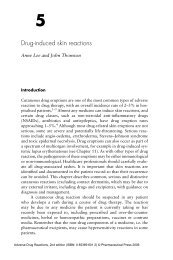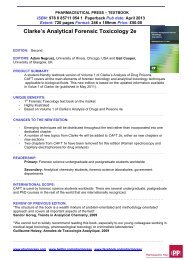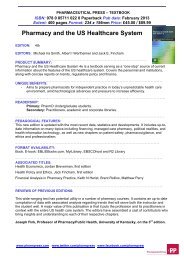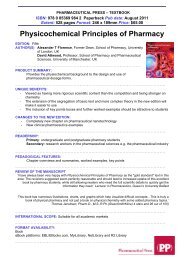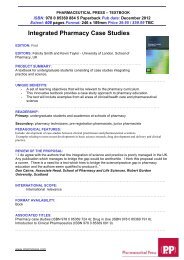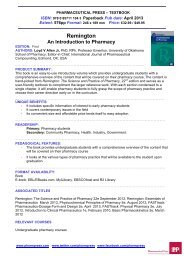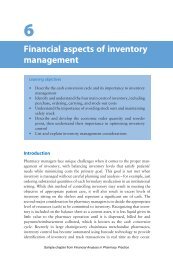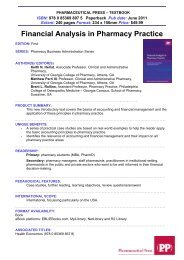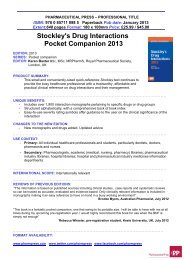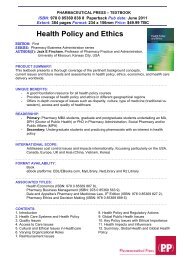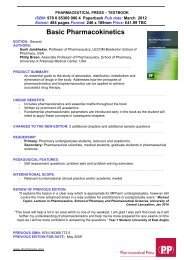11 Chap 11 (bc/d) - Pharmaceutical Press
11 Chap 11 (bc/d) - Pharmaceutical Press
11 Chap 11 (bc/d) - Pharmaceutical Press
Create successful ePaper yourself
Turn your PDF publications into a flip-book with our unique Google optimized e-Paper software.
204 <strong>Chap</strong>ter <strong>11</strong> • Formulation and physical properties of soft capsules<br />
Differential scanning calorimetry (DSC) and<br />
dynamic mechanical thermal analysis (DMTA)<br />
have been reported as suitable methods to<br />
monitor phase transitions and elastic moduli<br />
indicating molecular gelatin/plasticizer interactions<br />
and their effect on shell elasticity, i.e. to<br />
evaluate plasticizer effectivity and compatibility<br />
(Reich, 1983, 1994).<br />
An ideal plasticizer should interact with the<br />
gelatin molecules in such a way as to reduce<br />
effectively the glass transition temperature (T g)<br />
of the gelatin shell without inhibiting the formation<br />
of crystallites that stabilise the threedimensional<br />
gel network structure. In addition,<br />
if present in concentrations higher than saturation,<br />
it should be physically embedded in the sol<br />
phase of the gel network to avoid bleeding out<br />
(Reich, 1994).<br />
Glycerol, the most frequently used soft gelatin<br />
capsule plasticizer, combines these advantages of<br />
a high plasticizer effectivity, a sufficient compatibility<br />
and a low volatility with the ability to<br />
interact specifically with the gelatin allowing for<br />
the formation of a stable thermoreversible gel<br />
network. Its plasticizing capability is mainly<br />
resulting from direct interactions with the gelatin<br />
and only slightly from its hygroscopicity allowing<br />
for an additional indirect moisturising effect<br />
(Reich, 1994).<br />
Sorbitol, on the other hand, is an indirect plasticizer,<br />
mainly acting as a moisturising agent with<br />
water being the effective plasticizer. Compared to<br />
glycerol, its direct plasticizing capability is very<br />
much reduced, as indicated by a minor reduction<br />
of the gelatin glass transition temperature.<br />
Gradual differences of various grades of noncrystallising<br />
sorbitol solutions in their plasticizing<br />
capability and their compatibility with gelatin<br />
are the result of differences in the amount of byproducts,<br />
namely hydrogenated oligosaccharides<br />
and sorbitol anhydrides, i.e. sorbitans (Reich,<br />
1996). Only sorbitol grades with a high amount<br />
of sorbitans, such as Anidrisorb, can effectively<br />
replace glycerol owing to a certain direct plasticizing<br />
effect. On the other hand, hydrogenated<br />
oligosaccharides such as maltitol in combination<br />
with glycerol are very effective additives for the<br />
formulation of chewable soft gelatin capsules,<br />
since they augment the taste and chewability and<br />
assist in the rapid dissolution of the shell upon<br />
chewing, thus improving the mouthfeel (Berry<br />
et al., 1988; Montes and Steele, 1999).<br />
Regarding plasticizing capability, propylene<br />
glycol is superior to sorbitol/sorbitan blends and<br />
even to glycerol. However, owing to its high<br />
solvent power for gelatin, it has a slightly negative<br />
effect on the formation of the gel structure<br />
that has to be compensated for by adjusting the<br />
manufacturing parameters at the encapsulation<br />
machine (Reich, 1994). Liquid polyethylene<br />
glycols can only be used in combination with<br />
glycerol or propylene glycol, since their compatibility<br />
with gelatin is limited.<br />
Other additives<br />
In addition to gelatin, the plasticizer(s) and water,<br />
optional components in the capsule shell are<br />
limited in their use. For economic reasons, the<br />
addition of active ingredients in the shell is<br />
usually not recommended and limited to inexpensive<br />
compounds in chewable capsules. The<br />
use of water-insoluble polymers to impart sustained-release<br />
characteristics to the capsules has<br />
failed owing to their limited compatibility with<br />
the gelatin mass (Reich, 1983). Formulations<br />
with gastroresistant enteric soluble polymers are<br />
under development.<br />
Colouring and opacifying agents are used frequently<br />
to give the shells the desired colour and<br />
a proper finish, i.e. to allow the shell to protect<br />
the fill from light and to mask the unpleasant<br />
look of the fill. As a general rule, the colour of the<br />
capsule shell is chosen to be darker than the<br />
colour of the fill. Before a colour is chosen, mixtures<br />
should be checked to ascertain that fading<br />
or darkening of the capsule shells does not occur<br />
on storage, as a result of reactions between the<br />
colouring agent and other components of the<br />
shell or fill.<br />
Fill compositions<br />
Soft gelatin capsules can be used to dispense<br />
active compounds that are formulated as a liquid<br />
or semi-solid solution, suspension or microemulsion<br />
preconcentrate. The formulation of the<br />
fill is individually developed to fulfil the following<br />
requirements:



